Love your log, love the food porn.
You make the minimalistic life sound pretty great.
Now if I could just convince my wife to sleep on a cot...
User Tag List
Results 711 to 720 of 1667
Thread: The LIFE log of Scope75.....
-
03-15-2013 #711Established Member Feedback Score 0



- Join Date
- Feb 2013
- Location
- Dudeafornia
- Posts
- 279
- Mentioned
- 0 Post(s)
- Tagged
- 0 Thread(s)
-
03-15-2013 #712A 1k Club Member Feedback Score 3 (100%)



- Join Date
- Nov 2012
- Location
- Salad Bowl, CA
- Posts
- 3,346
- Mentioned
- 0 Post(s)
- Tagged
- 0 Thread(s)
I'm loving it right now. I'm surrounded by everything I need and that's it.
The first weel I was going to stay at my house all I took was a sleeping bag and cot to sleep on. Luckily I spent that first week at a girls house. Lol
I even wash my clothes at work because I don't have a washer and dryer.
-
03-15-2013 #713
-
03-15-2013 #714A 1k Club Member Feedback Score 3 (100%)



- Join Date
- Nov 2012
- Location
- Salad Bowl, CA
- Posts
- 3,346
- Mentioned
- 0 Post(s)
- Tagged
- 0 Thread(s)
I eat like a King thou!!!
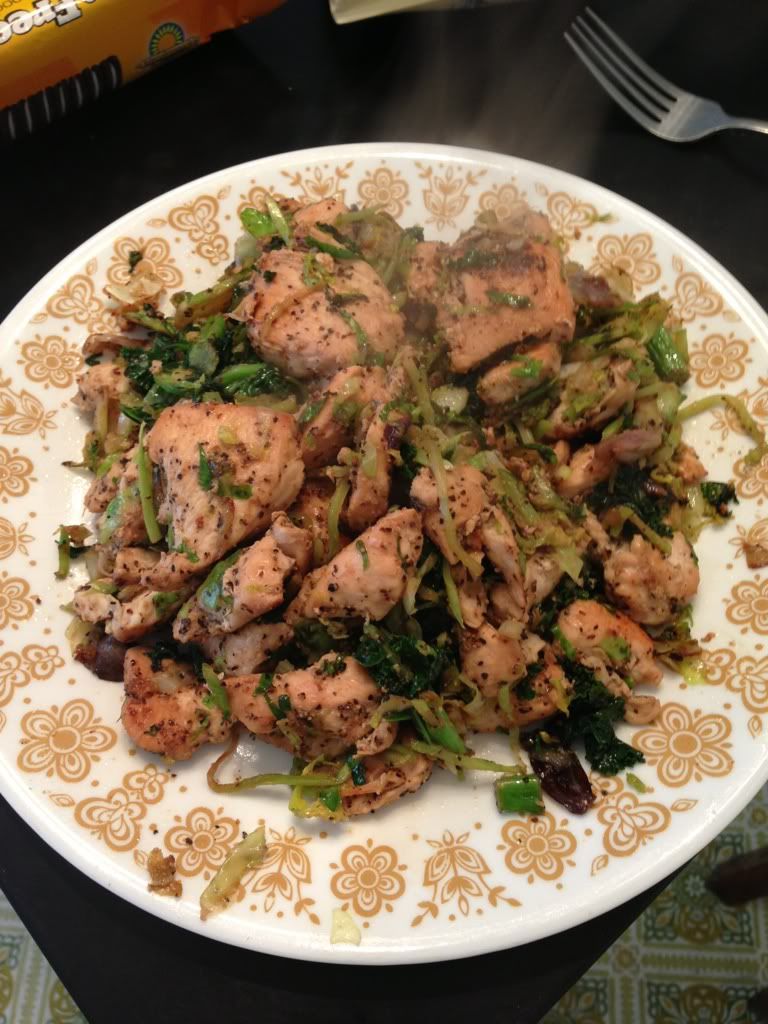
-
03-15-2013 #715A 1k Club Member Feedback Score 3 (100%)



- Join Date
- Nov 2012
- Location
- Salad Bowl, CA
- Posts
- 3,346
- Mentioned
- 0 Post(s)
- Tagged
- 0 Thread(s)
Meadows interviews Kiefer
This is from September 2012... Pt 1. Meadows interviews Kiefer via mountain dog
-----------------------------------------------------------------------------------------------------------
JOHN: I am extremely excited to announce that this month we have the creator of the very famous and successful carb-backloading style of eating, John "dangerously hardcore" Kiefer! Kiefer, tell us a little bit about yourself, your roots, and what you are passionate about!
DH: Hey John, thanks for taking the time to do this interview with me. I had a lot of fun on our radio interview last month, as I don't get to talk to many people with such a deep knowledge of training and diet. Now, you can say I'm a bit of geek, as I've got a masters in physics and engineered software for over a decade before quitting to spend all my time on my passion, which is improving human performance. To be clear, not just performance at sports, as I'm currently known for, but performance at life. Everyone should be healthy, strong and, well, a bad ass everyday day of their life. So a few years ago I dropped a lucrative career to get what I've learned out there to the public. Since I grew up as a fat kid, I always wanted to figure out how to look like the guys on the magazines and after every single diet disappointed me, I hit the research journals and read...and read. After a dozen or so years of researching and experimenting I wrote my first book, The Carb Nite Solution, but I didn't know anything about marketing or how to get myself out there, so I shelved it. Then a few years ago and even more reading, learning and experimenting, I gave it another run and wrote Carb Back-Loading, which, in my eyes, is a revolution in the diet world. But, to be honest, the only reason anybody knows who I am is because the diet just plain works and it's stupid-simple to apply.
JOHN: I actually purchased it myself, when I read something along the lines that there is a major focus on nutrition around training. I absolutely loved it! I think that periworkout nutrition is 80% of the ballgame. Can you tell us a little bit about eating around training, and about why it's so important?
DH: Where to even begin. I remember when I was a newbie and had some weird vision of my time in the gym, that every rep of every set triggered growth. Now I understand that every one of those reps sparked destruction, it's only that the workout opens an anabolic window when it's finished. Because of the catabolic behavior of training that proceeds the anabolic environment, you want to introduce nutrients through the entire process (during in some cases, and after always) to prevent catabolism and fuel anabolism, respectively. Plus, heavy training creates unique metabolic scenarios that we can take advantage of. For one, post-training, it's nearly impossible to trigger fat storage; another is the cellular reactions training triggers that allow muscle cells to soak up carbs but leaves fat cells impaired to do so. There's also the hormetic free-radical response which is a major growth trigger and one you can finely tune with nutrition. And there's heightened mTOR activation, which is another nutrient-modulated growth pathway...and the list goes on. I could probably fill this entire interview with just each of the individual reactions that take place when you train and the arrangement of food to conduct a symphony of growth. Which, oddly enough from our discussions, you've already seemed to have pretty well tuned, science be damned. I almost want to ask one more time how the hell you came so close--as close as person could possibly get without well-controlled studies--to what I consider the perfect diet. But this is your interview...
JOHN: HA! I did exactly what I am doing now. I found people smarter than me (like you), and learned from them. I had Dr. Eric Serrano mentor me for years and years, and I learned from many others along the way. Tim Patterson (owner of Biotest) is somebody who has opened my mind alot to in recent past. I did quite a bit of reading and writing, and seeing and experimenting in the trenches always provided clues if I just paid attention. Many times I would figure something out, then go back and try to find how it could work via scientfic text. Sometimes it would back me up, sometimes it would say I was dead wrong. So finding people like you, and learning, was and always will be something I strive to do.
I really like the way you put training into context using the word "destruction" and this leading to a window. I call this creating "opportunities". The more opportunities you can create, the more potential you have to grow muscle.
In your opinion, what are the key elements, techniques, etc, with training that create this environment. Can I go run a mile and create this? Do I need to do a heavy single? Something in between?
DH: I feel like you're giving me the opportunity to rant here, but I'll refrain, at least a little. Cardio is absolutely your worst exercise modality for creating the optimized anabolic window for growth. Not that it can't trigger growth with the right supplementation (such as loading with leucine immediately after), but it's not going to spark actual hypertrophy; in fact, it makes muscle cells smaller and more compact and ultimately limits growth. For the ideal environment--and I'm speaking purely about anabolic and hypertrophic signaling--you need at least a heavy load that's less than a 10-rep max and that load needs to be taken to failure for at least 1 set on upper body movements and 3 sets on lower body movements (and I can't explain why there's that difference, but the research confirms this discrepancy). As an example, if you're 6-rep max for bench is 315, you'd need to do at least one set of bench in that workout with 315 taken to failure (which should be 5-7 reps depending on how your body "feels" that day).
JOHN: Now this is why you are one of my favorites. Talk a little bit more about muscle cells getting smaller.
DH: Sure. It's an interesting phenomenon and considered a bit of a paradox. The size a muscle cell can ultimately obtain is based on the nuclei density which is also related to mitochondrial density. In essence, the muscle needs to increase in oxidative capacity--i.e. increase the anaerobic threshold of the muscle--to obtain maximum size. Standard hypertrophy training, however, actually decreases muscle cell nuclei concentration (resulting in about 40 nuclei per muscle cell) as it increases the cell size. Sprint-endurance training, however, increases the number of muscle cell nuclei (resulting in 60 nuclei per cell on average) but at the same time makes muscle cells smaller and more compact rather than increasing size as hypertrophy training does. It takes particular combinations of the two, or correct staging of sprint-endurance training with resistance training to force muscle to increase in both size and potential.
JOHN: Variation in program reps and design. I like what I am hearing.
In order to repair or even prevent the destruction that you mention, what is the best way to do this nutritionally?
DH: There are four things that are critical: Fish-oil supplementation throughout the day and regularly, as this keeps cells at maximum anabolic efficiency, simply because they're healthier when long-chain omega-3s (in fish oil) become incorporated into the cellular membrane. After training (and possibly during) the key trifecta is whey or casein hydrolysates, creatine and leucine. This prevents or attenuates damage intra-workout and triggers massive growth signals post-workout. I would be remiss to ignore a longer-acting support protein for that growth spike, like whey isolate or a mix of whey isolate and micellar casein. Although hydrolysates and leucine trigger growth, the amino-acid spike they provide is too short-lived to actually support the growth, so you need another, slower absorbing protein in the mix.
JOHN: I have always read that including some saturated fat in your diet also actually helped with the Omega 3 retention in tissue, any thoughts on that?
DH: I've read that before, but I think it's a bit of trick question here because it depends on the source of omega 3. If you're getting omega 3 from plant sources, it's primarily alpha-linolenic acid which needs to be converted into EPA and DHA for full effectiveness. The problem, however, is that the enzymes needed to make these conversion may shift alpha-linolenic acid into several different end products, like saturated and mono-unsaturated fats, plus these enzymes are limited, so if you don't get enough saturated fat--which is necessary for cell-membrane structure and hormone production--the body will "waste" some of the alpha-linolenic acid by converting it into less functional derivatives instead the key factors EPA and DHA. That's why I always recommend supplementing with fish oil because of the high amount of EPA and DHA rather than putting the burden on your system to make it from a raw material. But...saturated fat is a key component to health and energy production, so it should be included in the diet regardless.
JOHN: What if we are still sore in a particular bodypart? Is it ok to train a sore muscle if our goal is hypertrohy?
DH: For hypertrophy, there's no need to skip a bodypart because of 2 or 3 day DOMS (or even over a week in some cases). That type of soreness is caused by nuclei damage in skeletal muscle cells that allow calcium to leak into the surrounding tissue. This is normal and the body adapts to create protective proteins to protect against damage in subsequent sessions. If you're sore for days after every workout, then you're not meeting minimum protein needs necessary for repair and growth (I think baseline protein-turnover rates are 0.8g/kg of body mass...that's the minimum necessary to prevent wasting). The real thing to worry about and not over-stress, is the nervous system. Muscle tissue is always recovered within 36 hours and ready for more training despite the DOMS...the nervous system, however, can take over 7 days to recover is overtaxed.
JOHN: What are your thoughts on reviving a burned out CNS. I have always thought shorter more frequent workouts seemed to do a nice job, especially when the training was more "explosive" in nature, and not so much "grinding" in nature.
DH: I'm in total agreement with you here. Although a lot of people aren't fans of the idea of a burned out CNS, it's clearly a real phenomenon as demonstrated by the research. I actually created and released a free template of my Shockwave training that was designed exactly for such a scenario. I dug through the research to find something that I could use even when I felt burned out instead of taking a week or two off. No because I'm some masochistic freak, but because I love going to the gym, I love the feeling of a good pump and I need some opportunity to make my body do meaningful work after my mind's work forced it to sit most of the day. Two concepts I developed from the research are Partitioned Set Ramping (PSR) and Self-Modulated Progression (SMP). PSR, simply, is using lighter loads at the beginning of the set of an exercise and developing force through acceleration then moving up until you're generating force through increased load. This has been shown to "wake-up" the nervous system and can allow for greater power production throughout the workout (and I'm starting to lean toward the idea that the most important factor for hypertrophy is riding the edge of constant peak power production (CP3). The nice thing about PSR sets is that your nervous system will tell you when it's had enough since you simply can no longer accelerate the load at some point. And if it's not truly exhausted, this kind of scheme wakes if up and actually energizes the remaining workout. SMP, on the other hand, is almost a throwback to the Weider Principle days. At its heart is "listen to your body". We've come to the point of believing that if the training templates says you've got to hit your 3 rep-max on squats on Monday of next week and it should be 25 lbs more than your 3-rep max that you hit 2 weeks ago, and if you don't, you somehow failed. The body isn't always in prime condition for maximum effort. Research has shown that strength athletes progress faster by training to the max of how they feel rather than the prescribed max on their templates. The two principles together, PSR sets plus SMP can help to both avoid CNS burnout and recover more quickly from it by allowing the CNS to activate without getting taxed.
JOHN: This is why I love accommodating resistance. You can train this explosiveness so well. Many times as you go up in weight via chains, the weight actually feels lighter as your nervous seems to start hitting on all cylinders. Training with bands seems a bit more complex though. I had very good success with some banded work on the leg press, bench, etc, but after 4 to 6 weeks, the gains would rapidly disappear. It appeared to me the eccentric overload was just too much to handle for over a month or so. Do you have any thoughts on eccentric loading and overtraining?
DH: I do. Eccentric overload has been shown to be great for hypertrophy gains, but that surprisingly doesn't carry over to strength very well. The reasons, as far as I can tell from the research, haven't been fully elucidated yet, but I would venture to say that three factors come into play. First, eccentric loading causes far greater damage to muscle cells which elicits growth, but doesn't allow for massive strength gains, but I would bet there's an upper limit to how long we can utilize this over-damage-for-growth principle before it stalls; Second, eccentric overload is harsh on the nervous system and there's only so long you can abuse the CNS before it says, "enough," and stops you from fully contracting muscles with each rep which is obviously going to slow down hypertrophy and strength gains; Third, eccentric overload can decrease GLUT4 and 12 efficiency and translocation, making it harder to transport glucose into cells which can decrease performance during training and prevent effective glycogen repletion after training. This detrimental effect would take some time to notice, say a month or two as the deficit accumulates. This matches with your observations nicely. But what do I know?
-
03-15-2013 #716A 1k Club Member Feedback Score 3 (100%)



- Join Date
- Nov 2012
- Location
- Salad Bowl, CA
- Posts
- 3,346
- Mentioned
- 0 Post(s)
- Tagged
- 0 Thread(s)
Meadows interviews Kiefer
This is from September 2012... Pt 2. Meadows interviews Kiefer via mountain dog
-----------------------------------------------------------------------------------------------------------
JOHN: John we left off talking about how eccentric overload can be a double edge sword, and can actually decrease glut-4 translocation if you overdo it. How about concentric loading? I don't know that I have an opinion on this yet, so I am open to you swaying me! Here is an example of something I love doing. Grab a rope with one hand, and pull a sled simulating a low row. You can "explode" and then as the weight comes to the end of a slide, just step back and repeat. There is no eccentric element at all. I think of it in terms that I am adding to the workload, without killing CNS. I have not built this into any of my programs yet though, as I haven't done it for a long enough period of time, to see a long term effect.
DH: This is an interesting question and one I thought a lot about just over a year ago and that's when someone introduced me to exactly what you're describing! I think this type of training makes a nice adjunct, but since learning about it, I'm not really sure of its place. The eccentric portion of training triggers most of your inflammatory damage (that also sparks growth), so when someone's beaten the hell out of their muscles or getting an abnormal frequency and intensity of the DOMS, then this concentric-only training is awesome and I can see a use. And like we discussed, it does initiate non-insulin mediated GLUT translocation, so it could be used with carb-manipulating protocols like CBL and the Mountain Dog brand of contest prep dieting. I'm not sold, however, on the claims I've heard of allowing CNS recovery. I think it's the intrinsic methodology and not the concentric isolation, as using a sled in this manner is normally done with higher reps and lower weight than you could handle for a really big pull. Essentially, your muscles tire from an energy systems-standpoint (buildup of proton donors) and not because you're really working the CNS. So, the CNS recovers, but only because you're simply using a load that burns you out before hitting the extremes of CNS activation. If you look at an activity like say pulling a semi truck with a rope, so you're just pulling hand over hand and not moving your feet, the CNS impact would be massive even though this is also concentric only. So, I guess what I'm saying in a long-ass way is, the jury's out, but it's still awesome to have a method of concentric-only training.
JOHN: We'll see where that one heads in the future. You mentioned the inflammatory process. This caught my eye, because for so many years, I think I was completely wrong about inflammation and soreness. I always wore my soreness like a badge of courage. The sorer I got, the better I thought I was doing. I did make progress, nice and steady progress. When I started really hammering pre, intra, and post workout nutrition, the soreness evaporated. At first I thought, oh man, I must not be training hard enough. As the soreness vanished, I was able to increase my frequency of training though. Gains tremendously accelerated. Now the best thing I can hear from a client is this, "John what am I doing wrong, I am not sore anymore?". With the tremendous amount of importance you place on nutrition around training, I am guessing you are hearing the same thing?
DH: I'm saying almost exactly the same thing. The studies on DOMS (delayed onset muscle soreness) always intrigued me because, although the soreness can last a few days, biochemically, muscle respond just as they do when there's no DOMS within 48 hours. The research also shows that you should also really only experience the DOMS once or twice (assuming you continue your training regimen), but I was like you, experiencing them regularly but still gaining. As I progressed and started including higher quality protein powders--gave up crap like Muscle Milk and Designer Whey--I noticed it stopped. What I later found out is that eccentric loading, in particular, triggers damage in skeletal muscle mitochondria which can cause calcium ion leakage. It's these ions that make you sore the next day. It happens pretty much every time you train heavy. But this also triggers several protective responses like the heat shock factor cycle. Your body actually builds up proteins to protect against residual damage, but it needs adequate vitamin and protein supplies to do so effectively. The bottom line, if you're getting the DOMS on a regular basis, your nutrition sucks.
JOHN: How did we go so wrong on this?
DH: I just think it's the nature of the beast. People who train seriously don't mind punishing themselves; it's like a badge of honor, as you said. I mean, just look at CrossFit: they've gone so far as to actually praise injury in lieu of results. So being sore for a few days, psychologically, gives you bragging rights about how much of a badass you are, so you start to expect it. When it goes away, you think you're not working hard enough, so you do stupid shit to make it happen again, just so you can feel like you succeeded. It's probably the only thing in life where success is measured in consistency of pain.
JOHN: So where do we draw the line with training. How much inflammation do we really need to trigger growth?
DH: Damn, you're pulling out the big guns here. I can't tell you for sure, but the answer's not much. Like I touched on before, inflammation is hormetic, a little bit triggers growth and too much pushes the needle the other direction into muscle breakdown. For example, that's one reason NOS supplements "might" work, because they increase levels of intramuscular nitric oxide which is an inflammatory (and is produced every time we train anyway). But what seems to be the case is that you only need to allow the inflammation response to last through your training, after which, you should be doing what you can to curb it. That's one reason carbs post-training can be a growth potentiator. The insulin release works as an anti-inflammatory. That would also explain (and I'm extrapolating here) the probable cause of stymied muscle growth while taking NSAIDS like acetaminophen (Tylenol) and ibuprofen (Advil), because they don't allow you to get the full hormetic response during the training session.
JOHN: Yes, and the way I approach it, is to curb the inflammation to a degree while training via carbs to drive insulin. I liken this to digging a ditch. I only want to dig it a foot deep. Then as I add dirt (protein synthesis, I quickly fill up the 1 foot and add to what there was orginially if I continue to add. Now if I were to dig it 10 feet deep during the session, I have to fill that up just to get back to status quo, let along beat where I started. That whole skeletal muscle turnover rate thing is a doozy.
Also, I believe excess inflammation can actually decrease insulin sensitivity and cause other issues - can you expound on this?
DH: I wish I could be technical on this one, but they've seen in studies that chronic inflammatory response (which can be from stress or over-productions of the bio-active omega-6 fatty acids like (arachidonic acid) cause cellular dysfunction at the membrane level, which itself could explain everything since insulin's only interaction with a cell is by stimulating GLUT4 and GLUT12 response through the cellular goo. This is something that I'm now going to have to put on my plate to research, because I hate not having a more detailed answer.
JOHN: Haha! Ok, we will look for a full report soon!
Ok, so here is something that I love arguing about with people. In bodybuilding, popular dogma has always been that in order to gain muscle at the absolute fastest rate, you have to get borderline fat, and basically eat everything in sight and do a "bulk up". I am 100% against this idea. I say to stay within 10% bodyfat generally speaking (sure some can get away with more), as I believe once you get too fat, fat cells in themselves can lessen insulin sensitivity (cytokines etc)...so the more fat you accumulate, the worse this happens, and the SLOWER the rate of growth. Building muscle at the fastest rate would mean to manage insulin sensitivity to a degree, and yes not be ripped, but again, decently lean. Please tell me if I am full of crap or if there might be something to what I am saying!
DH: I'm with you 100% on this one. I used to believe that gaining required bulking up, just like everyone else, but it doesn't. This is what my MTR concept is based on, Modulated Tissue Response. If you know what you're doing with food and supplements, you can continuously give your muscles the signal to grow while keep your fat cells at least at bay and if you spend enough time experimenting with yourself, and depending on how fat you are to begin with, you can drop fat and gain muscle at the same time. And like you said, as you start pushing the limits of what your fat cells can store, they release more and more inflammatory agents like tumor necrosis factor alpha (TNF-alpha), angiopoietin-like protein 2 (Angplt2), and can trigger macrophage activity that is related to even more inflammatory factors (a subset of the interleukin family, C-reative protein and so on), all of which mess with insulin sensitivity (like I said above, I can't explain the exact mechanism) and stymies growth of all cells, including muscle cells. Getting fatter means slowing growth. And you're absolutely correct, manipulating nutrient timing to keep insulin sensitivity at its peak is the fastest road to growth, which means avoiding getting fat and choosing the right time to ingest carbs.
JOHN: The other thing about getting too fat, is that it is going to require some major suffering to get down and look right, in which I think you will probably burn muscle off, and man it's hard enough to build muscle, so I sure as heck don't want to be a cardio bunny eating tuna and lettuce for months on end due to risk of eating muscle.
Ok, so here is another one for you. People talk about the post competition "rebound". You just had a long diet and your muscle cells will just soak up and all food you throw at it, so pig out! Isn’t is also true that your fat cells will also soak up stuff and grow if you overdue it, and you might actually create some NEW fat cells?
DH: If you prep carefully, the rebound should only serve to tighten you up. Most of my clients (especially females for some reason), will Carb Back-Load after coming off of a competition (and do they back-load: there's nothing like seeing a 5'2", 120 lb girl putting down a 16 inch pizza who is then ready for dessert shortly after), and lean down! They normally drop another 2 lbs of scale weight. It's because by prepping correctly, they don't end up in metabolic derrangement but metabolic overdrive.
With classic prep protocols (such as hours of cardio, starvation and over-exertion), people come off of a show with a devastated metabolism, increased glucose sensitivity in pancreatic beta cells and monstrous cortisol levels. The minute they start binging, cortisol levels are up and insulin levels get extremely high and this combination can cause pre-adipocytes to mature into full-blown fat storage units even if the surrounding fat cells aren't full yet! This, coupled with LPL (lipoprotein lipase which draws fat into cells) suppression in muscle tissue and amplified levels in fat cells means your body becomes a turbocharged fat-storing machine. Even in short time, you've drastically increased your potential to store fat. This is why so many woman who compete blow up and can never recover their previous stage shape because of the damage they do in as little as a few weeks. Fat cells can spring into existence at any time, but they take about 10 years to die. Can you say disaster?
JOHN: Ok. let's wrap this one up with some fun stuff.
1) What are your 5 favorite and tastiest foods to backload with?
5) Pizza
4) Cookie dough cookie sandwiches (smash raw chocolate chip cookie dough between two sugar cookies)
3) Fresh from the fryer raised-sugar coated donuts.
2) Coconut Gelato
1) Cherry turnovers
2) Favorite movie?
This is a tough one. It's a toss-up between Snatch, Real Genius, and Hitman.
3) Favorite book in regards to nutrition?
At least this one's a no brainer: Carb Back-Loading, of course.
4) Favorite comic book character if you’re weird like me into that kind of stuff?
Colossus from the old-school X-men comics (not the new-aged cream-puff from the movies).
JOHN: I just added a slide to my EliteFTS training presentation with a picture of the old Colossus today! Ha!
5) What is the first thing that comes to your mind when I say Eva Mendes?
That scene from the movie "The Other Guys" when Will Ferrell says, "I think to myself, 'Who would roast a dog's asshole and feed it to someone, You would.'" That scene, unfortunately, ruined my association of hotness with Eva Mendes and replaced it with hilarity.
JOHN: My image of her is an opening scene with Joaquin Phoenix from the movie “We Own the Night.” Watch it and the association of hotness will come right back guaranteed.
6) What is the worst trend in the fitness industry today in terms of nutrition?
Non-experienced people popping up as internet gurus because of their own personal success without any background knowledge or without having worked with people. This internet celebrity gives them the hubris to make shit up about nutrition and people think its fact. It helps no one.
JOHN: I’ll never forget the first time Dave Tate told me that many authors have never even trained one client. I thought wow, people writing books on fitness and having 0 experience. Scary.
7) Same question as above in terms of diet?
I'll be honest; it's the splintering and rebranding of so many concepts into kitschy names because everyone wants to be known for inventing something. It makes it hard for people to tell the difference between crap and cream and makes it easy for the old-guard to defame useful, powerful diets (like paleo or ketogenic diets) as fads. There are only a few types of basic diets as far as health and performance go and everything else is a shiny turd.
JOHN: Well once again, thank you DH for all your time and knowledge. I know our audience will absolutely love the information you have shared, and on a personal level, this has been awesome for me as well to hear your thoughts.
To all the readers out there, I have personally purchased the carb back-loading manual, and it was well worth the money, in fact, it's a steal for the price. I encourage you to pick it up as it is jam packed full of awesome information.
DH, what is the easiest way for people to do this?
DH: They can go to CarbBackLoading.com to purchase the book, or if they want a preview, they can download the first five chapters by visiting DangerouslyHardcore.com. Basically, the free download is a quick synopsis of what's the book can do for you!
-
03-16-2013 #717A 1k Club Member Feedback Score 3 (100%)



- Join Date
- Nov 2012
- Location
- Salad Bowl, CA
- Posts
- 3,346
- Mentioned
- 0 Post(s)
- Tagged
- 0 Thread(s)
Weekly update!!!
Well last week I was 216.6 and I was eating lots o food.
This week I'm 215.8 and that's with me cutting the shit out of cals. Lol
So after a week of lowered cals I'm down .8 pounds....
I'm super happy to not be dropping pounds and pounds while still leaning out slowly. I was hesitant to weigh myself this morning in fear of seeing the number on the scale drop below 212-214.
Today 215.8

Last week 216.6

-
03-16-2013 #718A 1k Club Member Feedback Score 3 (100%)



- Join Date
- Nov 2012
- Location
- Salad Bowl, CA
- Posts
- 3,346
- Mentioned
- 0 Post(s)
- Tagged
- 0 Thread(s)
Just finished a box of these Marshmellow Pebbles...
244g to start things off.
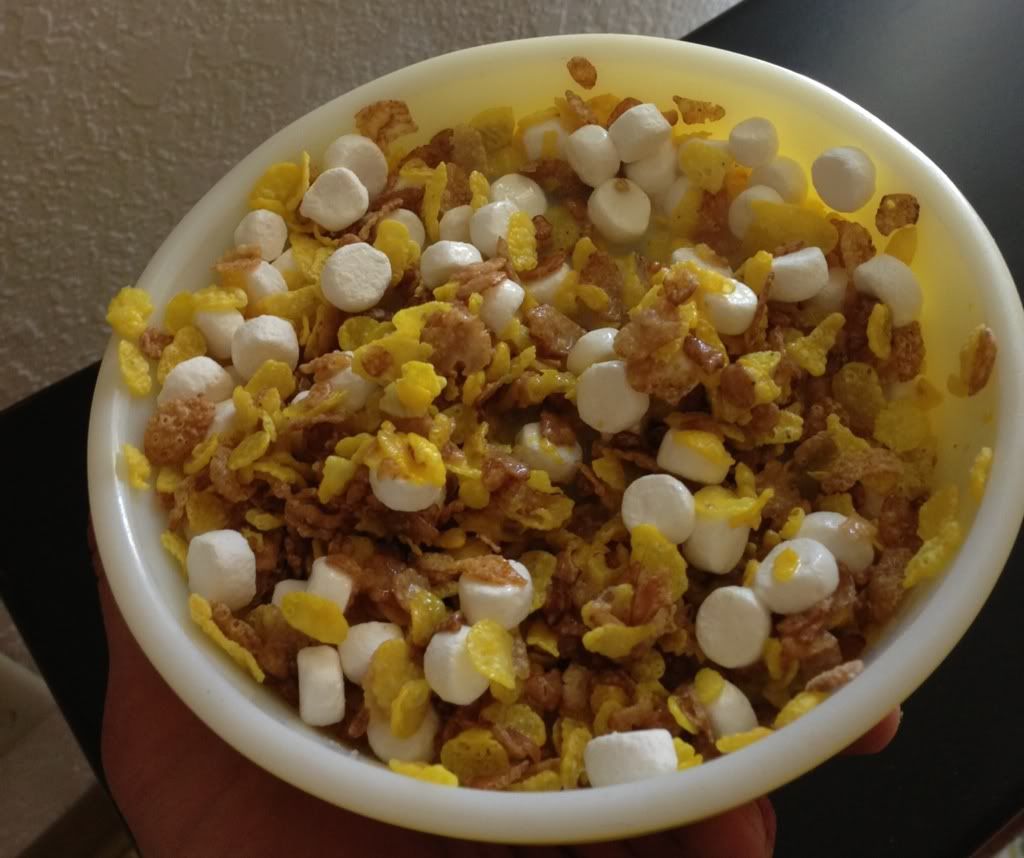
Also had a 2 MJ PB cookies, and 2 fat bowls of Incredible Hulk!!!
-
03-16-2013 #719A 1k Club Member Feedback Score 3 (100%)



- Join Date
- Nov 2012
- Location
- Salad Bowl, CA
- Posts
- 3,346
- Mentioned
- 0 Post(s)
- Tagged
- 0 Thread(s)
Tonight's Sushi
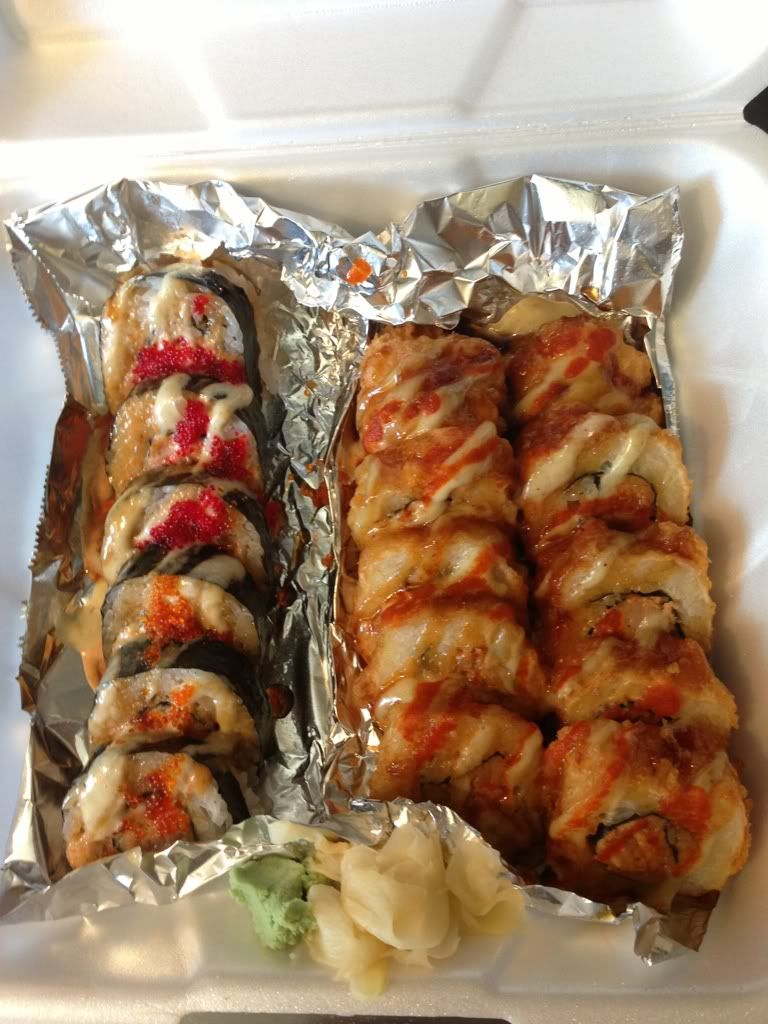
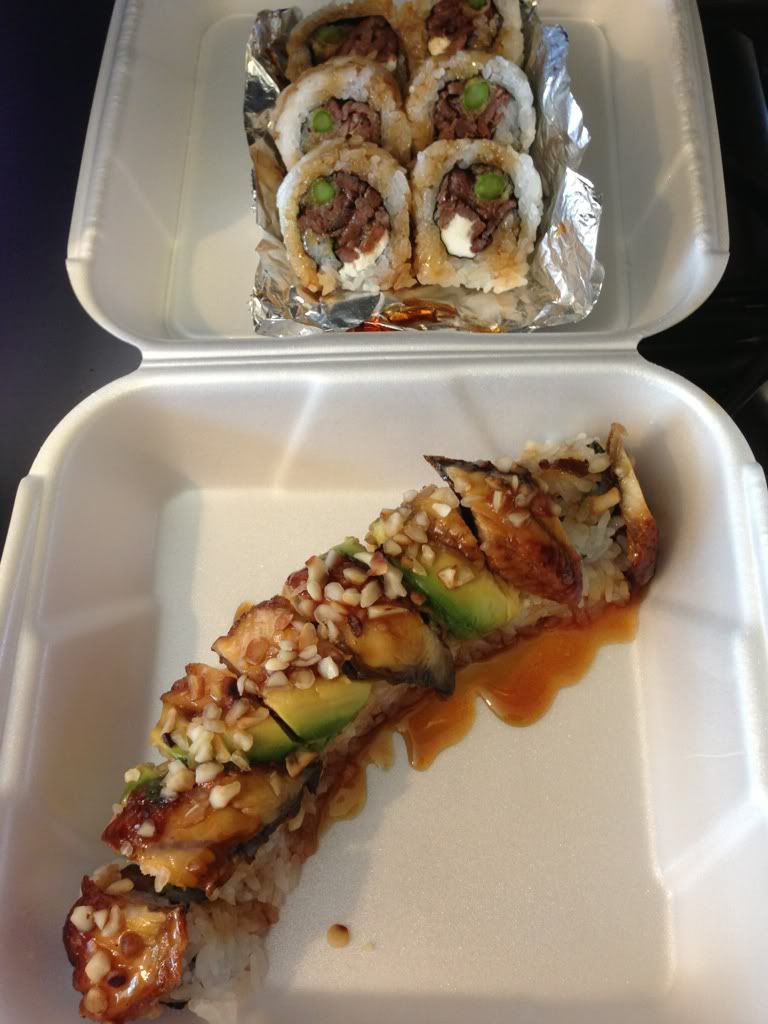
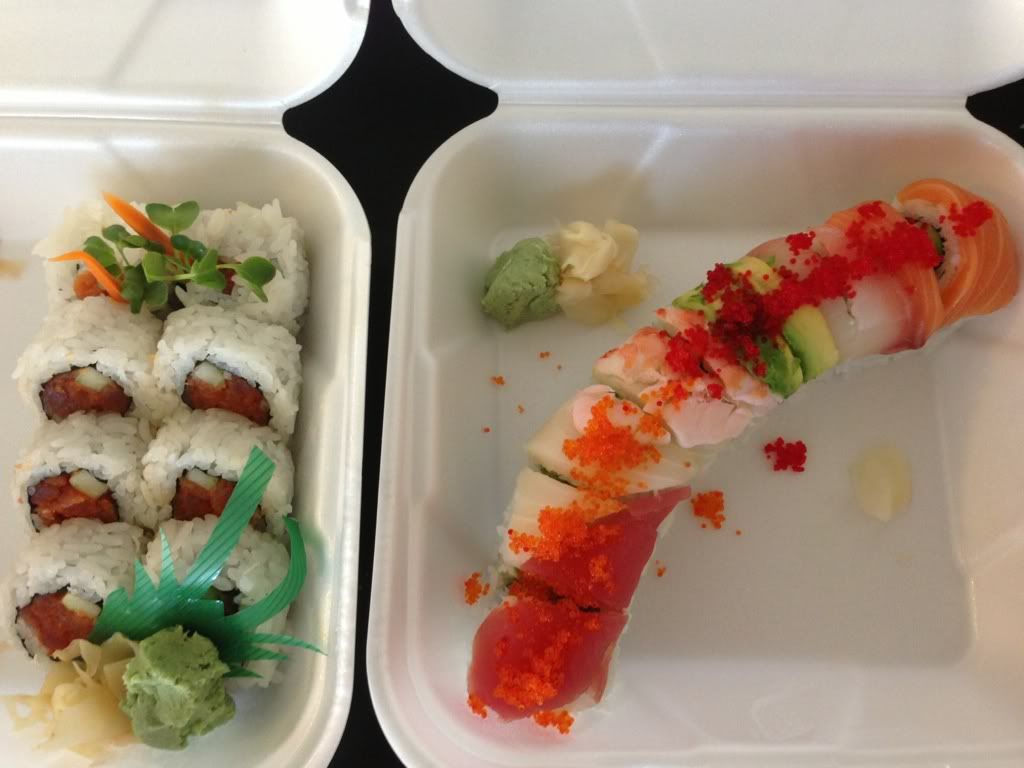
-
03-16-2013 #720A 1k Club Member Feedback Score 3 (100%)



- Join Date
- Nov 2012
- Location
- Salad Bowl, CA
- Posts
- 3,346
- Mentioned
- 0 Post(s)
- Tagged
- 0 Thread(s)
Tonight's Doughnuts!!
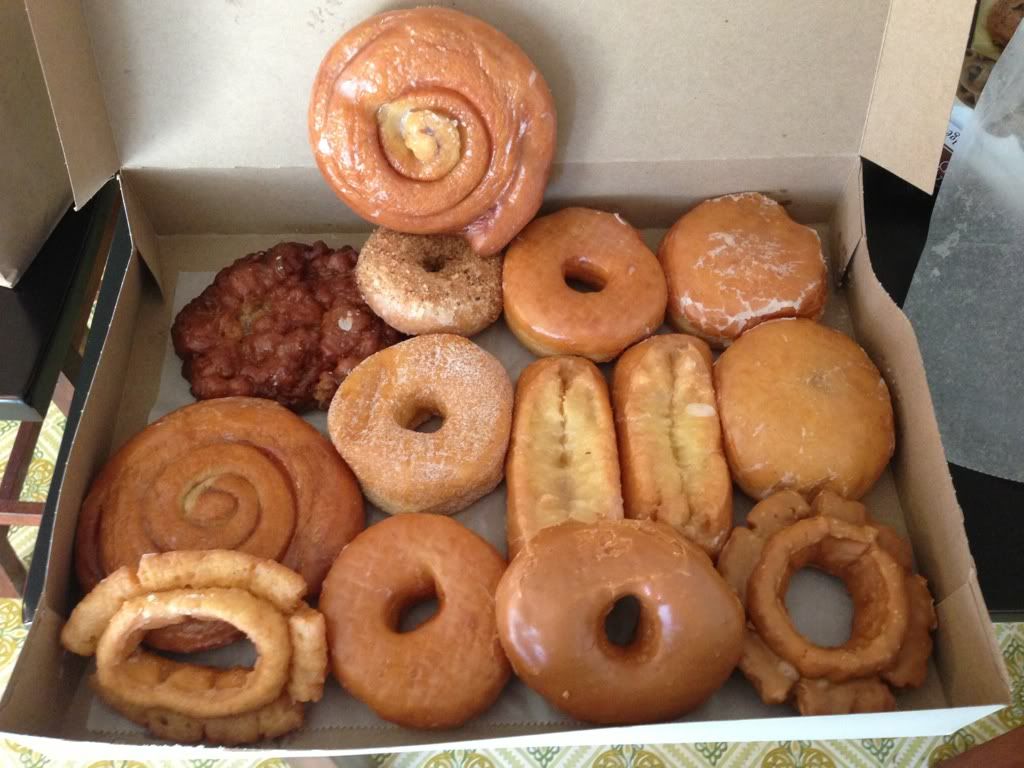
Yeah, yeah I know....
My cleaner/low fat CarbNite went out the window.
I drove past the doughnut shop made it one block flipped a bitch and picked up what you see in the pic.




 Reply With Quote
Reply With Quote

